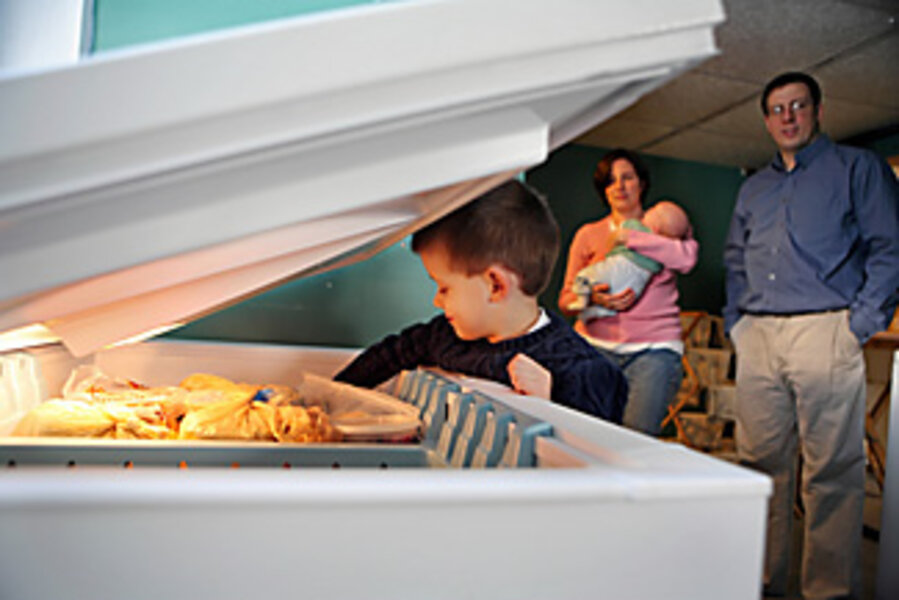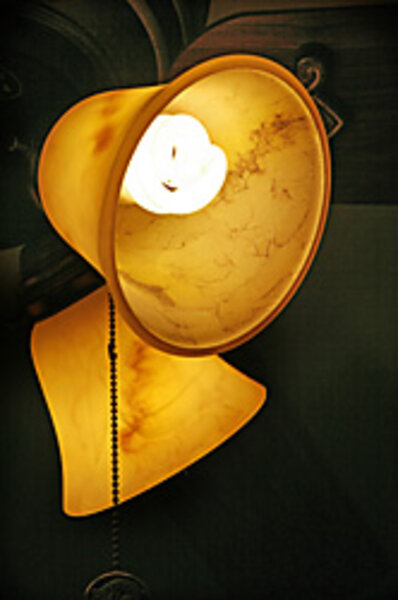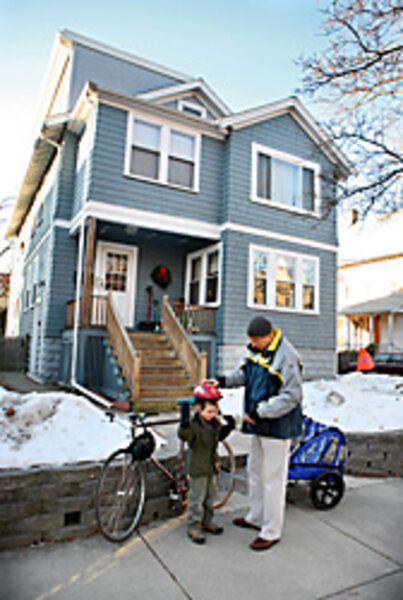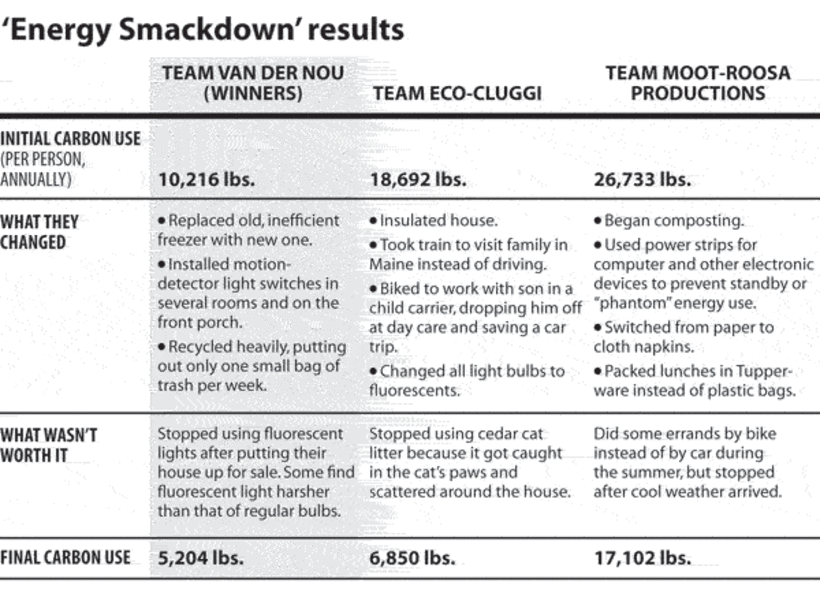Home energy use gets a 'smackdown' on reality TV
| Medford, Mass.
Most Americans know they should decrease their energy consumption, but many need a push to do it. Three families in this suburb north of Boston got that incentive by appearing on "Energy Smackdown," a reality TV show in which contestants competed to shrink their carbon footprint. The program aired on a local cable TV station during August and September.
With lifestyles ranging from überenvironmentalist to highly consumptive, each family was able to bring its footprint down by at least 30 percent in some surprising and "I can't believe I didn't think of that before" ways. All three teams found that, through a little friendly competition, making changes in their homes and lifestyles wasn't as hard as they thought.
"Before the competition, we were like most people, thinking we had gotten all the low-hanging fruit and done all we could," says Mieke van der Wansem of Team van der Nou. "Doing the competition made us realize there are some small things we can do around the house that aren't really that hard to get us over that plateau."
While Team Van der Nou (made up of Mieke, husband Steve, and young daughters Anneke and Sofie) was extremely ecofriendly to begin with, Team Moot Roosa Productions (featuring Alex Moot, Nancy Roosa, and children Ellis and Kaly) lived a more consumptive lifestyle that many Americans can identify with. The third family, Team EcoCluggi (Sarah and Jason Cluggish, with 4-year-old Sam), was somewhere in between, describing themselves as "normal people who are environmentally conscious."
"We chose three families that live different lifestyles so viewers could relate to at least one of the families and realize that anyone can do something without completely changing everything about their house or life," says Donald Kelley, producer of "Energy Smackdown" for TV3 Medford.
The initial reason for developing a television show about families saving energy was to encourage community awareness about ecofriendly options in their own homes, Mr. Kelley says.
While a TV show about how to cut your carbon footprint could have taken many forms, Kelley and his production team wanted to capitalize on the popularity of reality TV. He also tapped into the most recent research on the role peer pressure plays in making ecological choices.
According to a recent American Psychological Association study, people are more likely to make green choices if they think others are, too. And according to Karen Ehrhardt-Martinez of the American Council for an Energy-Efficient Economy, competitions "can be very effective" in inspiring change because "social incentives are often more effective than economic incentives in spurring people to change their behavior."
The competition began in March with a baseline assessment of each family's energy use. They plugged their lifestyle numbers (electricity use, travel, gas use, garbage generation) into a CO2 emissions calculator (www.epa.gov/climatechange/emissions/ind_calculator.html).
At the start, Team van der Nou was in the lead: It produced 10,216 pounds of CO2 per person per year, followed by Team Eco-Cluggi (18,692 pounds) and Moot Roosa at 26,733. The national average is 15,000 pounds per person.
Because a winner would be determined by which family could reduce their footprint the most, "We thought we'd be losers right off the bat, because we were already at our limit of what we can do," says Steve Lanou, Mieke's husband.
To improve their prospects, Team van der Nou decided to make a list of potential small changes, combining their own ideas and the suggestions of an energy auditor from their energy provider (a service most utilities provide free of charge – ask your local utility company).
"One thing that the auditor pointed out that was a real 'Aha!' moment for us was the fireplace," Mieke says. They typically left the fireplace flue open, which they learned was like leaving a window open.
Their energy company also donated a power-cost monitor (price: about $150), a small device that is wirelessly connected to their electric meter. It's so simple to use that even their young daughter Anneke can demonstrate it.
"Here it shows how much energy we're using," Anneke says, pointing to the digital display of 0.4 kilowatts per hour, the lowest reading. Then she clicks on the price-conversion button and says, "And here is how much that costs." The lowest meter reading is only 0.4 kilowatts an hour, and the energy auditor told them that now they are actually below that baseline.
"Whenever we see it's above 0.4, we walk around the house to see if we left a light on or see what's going on," Steve says. This diligence has helped the family cut their electricity use in half from the corresponding month the previous year.
In contrast, the energy auditor who visited Team Moot-Roosa said the family had their work cut out for them when it came to decreasing their energy footprint given their 1910, drafty, 4,000-square-foot home and minivan-dependent lifestyle. Both parents work in neighboring towns, while the two children are dropped off at independent schools.
"He rolled his eyes and said 'Hoo, boy' a lot," says Nancy Roosa of the auditor's visit. "We went into the show a little bit reluctantly, because we felt like we were energy sinners!"
Instead of undertaking the most daunting – and expensive – remedies, they opted for a few smaller changes: composting, installing compact fluorescent lights, using power strips to combat "phantom" energy use, changing to cloth napkins, and carpooling.
In the Cluggish household, the first thing to go was a family heirloom of sorts: a 30-year-old upright freezer in the basement that had belonged to Sarah's grandmother. The family had thought about replacing it for a while, but just never got around to it until the energy auditor informed them it represented almost 30 percent of the household's electricity use. (Upright freezers are generally less efficient than chest-type freezers because upright models let more cold air escape every time they're opened. In addition, any older fridge or freezer is typically much less efficient than their newer counterparts.)
Another major renovation was installing insulation, an important energy-saver that is inadequate or lacking in perhaps 40 percent of New England homes, according to the Massachusetts Division of Resources. Insulation was a change the Cluggishes had thought about before, but they figured it would cost too much until the energy auditor told them of a rebate program from their utility. Instead of a $14,000 insulation bill, the cost was only $2,000 after the rebate.
Each family also made lifestyle changes, although Team van der Nou took things the farthest. At the start of the competition in March, the family turned down the heat in their home to 58 degrees F., placing cozy blankets on couches and chairs in certain areas of the house when it got chilly.
When things warmed up in the summer, rather than running an air conditioner, they pulled down their window shades during the day to keep their two-story home cool.
And they took cool showers – in the dark.
"You don't need much light to have a shower," Mieke says, "so Steve would keep the lights off in the bathroom in the morning during the summer when it was fairly bright in the morning. It was kind of funny."
Some of the things the families did for the competition they won't continue to do because of the hassle factor. One such change was using cedar shavings for the Cluggishes' cat litter. (Cedar shavings are considered more environmentally friendly because the Bentonite clay used to make traditional litter is strip-mined, and the shavings are a renewable resource.)
"The cat would get these shavings in its claws and drag the shavings through the house," Jason explains.
And old habits die hard: Sarah has what she calls a "bottled-water addiction" that has been hard to control even after the competition, she says.
In the end, the "average" Cluggish family decreased its carbon footprint by 63 percent (to 6,850 pounds per person annually), the highest percentage cut of all the families. But that was before the final challenge.
The "überenvironmentalist" Team van der Nou won the overall Smackdown title thanks to the final competition: the community challenge. This contest required the teams to get their friends to save as much energy as possible. Team van der Nou came up with the idea of buying 176 compact fluorescent light bulbs and giving them to friends.
"It was a good idea they had," says Sarah Cluggish. "Most people know that fluorescents are better for the environment, but they need it handed to them before they'll actually replace all their light bulbs."
Thanks to that idea, which offset their carbon use with the decreased carbon output of their fluorescent-using friends, Team van der Nou effectively reduced its carbon footprint per person by 96 percent. Without the competition challenges and just tabulating their actual household annual carbon output, the family still only produces 5,204 pounds of carbon, about one-third the national average.
TV producer Kelley is now looking for families from Medford, Arlington, and Cambridge, Mass. (info@energysmackdown.com), for a second season. This time, whole communities will compete against one another to decrease their carbon footprints.
The competition aspect was an important part of what made the show a success, Kelley says.
For example, the friendly push to save energy helped inspire 4-year-old Sam to change more than typical parental nagging did, Sarah says.
"When I reminded him to close the fridge door, I'd say, 'Don't waste energy or we'll lose the Smackdown!' And he'd go 'Oh!' and close it right away,' " she says.
"It was a lot of fun," Nancy Moot says. "When you're alone trying to conserve, you're like, 'What difference does it make?' It was nice to have someone looking over our shoulders to hold us accountable. Now I think getting the community involved is the only way to go."
Indeed, the sense of community and friendly competition banter was part of the fun, Sarah says.
"People asked 'Aren't you relieved the competition's over?' " Sarah says. "But it didn't feel like a huge burden. We're paying 25 percent less for electricity, and I don't mind that my kitchen isn't overflowing with plastic bags now that I take tote bags to the grocery store."
In terms of the main idea she took away from the competition, Mieke says, "We learned it's not that hard to decrease your footprint but still live comfortably."








